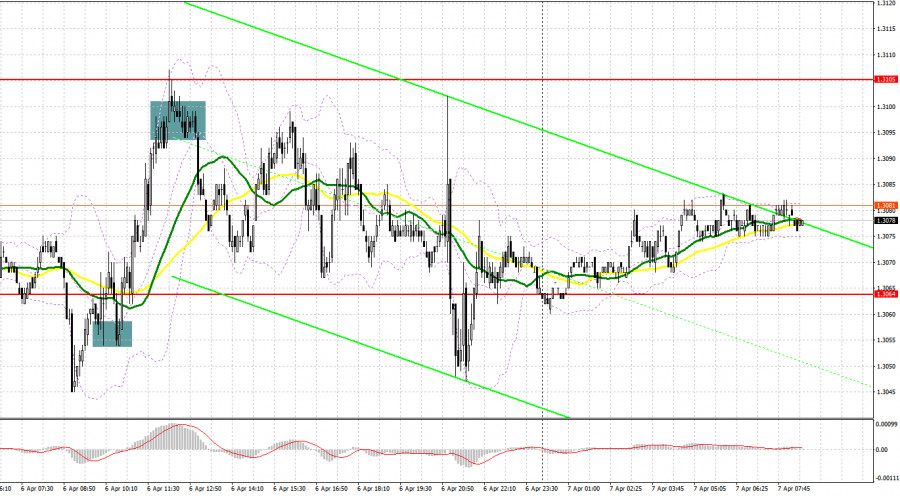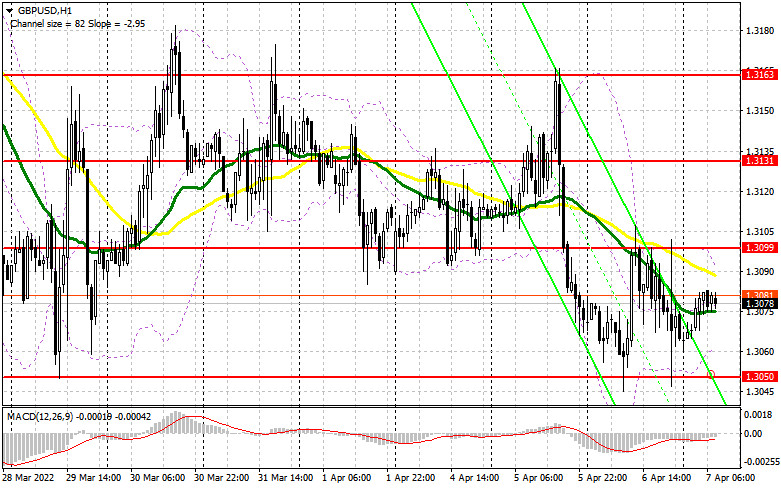
Yesterday, several signals were formed to enter the market. Let's look at the 5-minute chart and figure out the entry points. In my morning forecast, I paid attention to the level of 1.3059 and advised you to make decisions on entering the market. The sharp movement of the pound to this level and the instant breakthrough only confirmed the bearish nature of the market. However, it was not possible to settle below this range again – there was no reverse test of 1.3059 from the bottom up. A fairly quick return of the bulls' initiative in the first half of the day and the level of 1.3059 led to a reverse test from top to bottom – it was a direct signal to buy the pound while expecting an upward correction. As a result, the pair grew by more than 45 points and hit the resistance of 1.3093. Considering that the movement above this range was quite intense, the reverse test from top to bottom created a buy signal, on which losses were recorded, since there was no one who was willing to continue buying at the current highs and so the pair returned to the area under 1.3093. There were no signals to enter the market in the afternoon, since the Federal Reserve's minutes did not particularly affect the pair's direction.

To open long positions on GBP/USD, you need:
The fact that pound bulls once again defended the rather important and large support level of 1.3050 indicates the presence of major players there, counting on the recovery of GBP/USD in the medium term. Market expectations regarding the March Fed minutes fully coincided with what the Fed representatives said during the committee meeting. The only unexpected news was the likely beginning of the reduction of the Fed's balance sheet as early as next month after the May meeting. This indicates a tougher stance of the central bank on monetary policy, which will continue to support the US dollar and weaken risky assets such as the pound. There are no important statistics for the UK today, so pound bulls will get a good chance to break through and 1.3099 and return the pair to the upper boundary of the horizontal channel at 1.3163. However, the key task for the European session is to protect the 1.3050 support. Only a false breakout at this level will lead to forming the first buy signal that can return GBP/USD to the 1.3099 area, just below which the moving averages are playing on the bears' side. The 1.3050 level is also the bulls' last hope, as it acts as the lower boundary of the horizontal channel in which the pair has been since March 28. If this scenario is implemented, only a breakthrough and a test of 1.3099 from the top down, together with strong data on the housing price index from HBOS in the UK and hawkish statements by the member of the ILC of the Bank of England Hugh Pill, will form an additional entry point for opening long positions, which will strengthen the bulls and open the way to growth in the area of 1.3131. A more distant target will be the 1.3163 area, where I recommend taking profits. However, it will be quite difficult to get to this level in the current conditions. Only good news in geopolitics will be able to return the pound to the upper border of the horizontal channel. In case GBP/USD falls during the European session and a lack of activity at 1.3050, it is best to postpone long positions to a new low of 1.3027. I advise you to enter the market there only if there is a false breakout. You can buy GBP/USD immediately on a rebound from 1.3001, or even lower – in the area of 1.2960 and only with the goal of correcting 30-35 points within the day.
To open short positions on GBP/USD, you need:
Judging by what is happening, the bears may miss the chance to resume the downward trend. The primary task is to protect the intermediate resistance of 1.3099, just below which the moving averages pass. Forming a false breakout at this level will provide an entry point to short positions in order to strengthen the bear market and the subsequent decline of the pair to the area of 1.3050. However, it is difficult to say what should happen for the bears to break through this range. Bulls clearly have a completely different view of what is happening and just like that, without objective reasons, they will not let the pair go lower. A breakdown and a reverse test of 1.3050 will lead to the demolition of a number of bulls' stop orders and will give a sell signal, which will dump GBP/USD to the lows: 1.3027 and 1.3001. A more distant target will be the 1.2960 area, where I recommend taking profits. If the pair grows during the European session and bears are weak at 1.3099, this will not create any special problems for the bears, but it is best to postpone short positions to 1.3131. I also advise you to open short positions there only in case of a false breakout. You can sell GBP/USD immediately for a rebound from the high of 1.3163, or even higher – from 1.3192, counting on the pair's rebound down by 30-35 points within the day.

I recommend for review:
The Commitment of Traders (COT) reports for March 29 logs an increase in short positions and contraction in long ones. This indicates concerns about ailing economic conditions in the UK and risks of higher inflation. These factors are likely to exert heavier pressure on British households. Experts say that the economic conditions in the Kingdom will get worse. For the time being, analysts find it hard to assess inflationary risks that are putting strain on the domestic economy. In this context, markets are disappointed with the softer stance of the Bank of England Governor. This won't allow buyers of risky assets to add long positions on the pound sterling because they cannot rely on further rate hikes. The only thing to cheer up the bulls is some positive outcome in the peace talks between Russia and Ukraine and steps towards peaceful solutions. At the same time, we should forget about the hawkish monetary policy of the Federal Reserve that sustains strong demand for the US dollar in the face of mounting risks of a recession in the second half of the year.
The COT report from March 29 reads that long non-commercial positions declined from 32,753 to 30,624 whereas short non-commercial positions increased from 69,997 to 70,694. As a result, the negative value of non-commercial net positions went up to -37,244 from -40,070. GBP/USD closed lower at 1.3099 against the closing price of 1.3169 a week ago.
Indicator signals:
Trading is conducted below the 30 and 50 moving averages, which indicates a further fall in the pound.
Moving averages
Note: The period and prices of moving averages are considered by the author on the H1 hourly chart and differs from the general definition of the classic daily moving averages on the daily D1 chart.
Bollinger Bands
In case of growth, the upper limit of the indicator around 1.3099 will act as resistance. In case the pound falls, the lower limit of the indicator in the area of 1.3060 will provide support.
Description of indicators
Moving average (moving average, determines the current trend by smoothing out volatility and noise). Period 50. It is marked in yellow on the chart.Moving average (moving average, determines the current trend by smoothing out volatility and noise). Period 30. It is marked in green on the chart.MACD indicator (Moving Average Convergence/Divergence — convergence/divergence of moving averages) Quick EMA period 12. Slow EMA period to 26. SMA period 9Bollinger Bands (Bollinger Bands). Period 20 Non-commercial speculative traders, such as individual traders, hedge funds, and large institutions that use the futures market for speculative purposes and meet certain requirements.Long non-commercial positions represent the total long open position of non-commercial traders.Short non-commercial positions represent the total short open position of non-commercial traders.Total non-commercial net position is the difference between short and long positions of non-commercial traders.